#Thethor
Explore tagged Tumblr posts
Photo
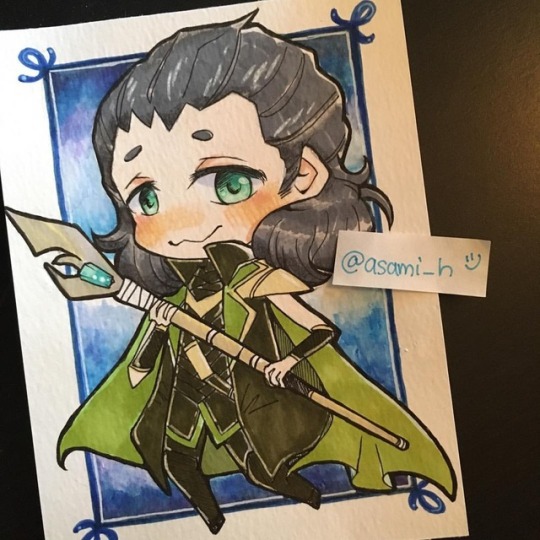
でも #loki たんの方が好きだったりするwww_(:3」z)_ #drawing #fanart #movie #doodle #thethor #marvel #お絵描き #マイティーソー https://www.instagram.com/p/Bo5hjFbF-b7/?utm_source=ig_tumblr_share&igshid=12uyifk1ifblr
3 notes
·
View notes
Link
https://www.wotablog.com/balloon-animation/
0 notes
Text
I read Daniel Warren Johnson’s Beta Ray Bill #1 and for the most part it was good. I liked that DWJ fixed that continuity error in Cates’ Thor regarding Bill. As always I love DWJ’s art and the fact that even if it's very distinctive to Walt Simonson’s it still has that feel similar to Simonson’s (the epicness, the big giant creative comic sound effects). I like that this is touching on Bill’s past. Fing Fang Foom was a nice touch although the Horse jokes got tiresome (and another fricking King in Black crossover).
The rest I’m kind of iffy about but it’s not entirely a deal breaker.
Like Bill being jealous of Thor because of how he’s in his shadow and how Thor gets all the glory while Bill does all the work doesn’t really feel like something Bill would think about Thor. I mean Bill came in and beat the crap out of Thor the first time they met, he was worthy of Mjolnir, and he even won against Thor in a contest to see who was worthy of Mjolnir. The whole reason he got Stormbreaker was so he wouldn’t take Mjolnir from Thor.
Most of the Aaron arc Bill gets to see Thor at his lowest, without being worthy of Mjolnir and not even being able to use his own name. Bill even offers Stormbreaker to Thor but Thor refuses because he knows how important Stormbreaker is to him. Also the Asgardians always recognized Bill for his valor and Odin told Bill that he saw him as a son. Hell, I think even Thor left Bill in charge of Asgard at one point in what was basically the All-Father position.
The only way I can make sense of Bill being like this is him feeling insecure about not having Stormbreaker anymore and all the crap Cates has put him through probably has him depressed. The way Thor has been behaving towards him doesn’t help either.
Now lets talk about Sif and Bill.
I always loved Sif and Bill’s relationship, at the time Thor was being messed with by Amora’s sister Lorelei and him and Sif were on the outs. In comes Bill and he reminds Sif of all of Thor’s good qualities. Bill tells Sif of his woes about how he lost his humanity and doesn’t think he will ever go back home even after saving his people because he feels like a monster. Sif reaches for his hand but Bill takes it away. But at this point she’s already taking a liking to him and this is before she knows he can turn into a regular Korbinite.
Throughout the Walt Simonson run there was a lot of heavily implied stuff between her and Bill. Mostly both of them waxing poetic at each other and having romantic drama. You never see them kiss, but you see them hug and touch and hold hands. They spend a lot of time together.
I think it’s this moment that really drives home that Sif and Bill are a couple and their relationship is much more intimate.

During their last moments close Sif gets dramatic about having to leave him.

But yeah you cannot convince me that they didn’t have any form of intimacy.
That said Sif spends time with Bill in his modified Korbinite form and in his regular humanoid Korbinite form and she shows attraction to him in both forms.
In Kelly Sue Decconick’s Sif #1 Sif meets Bill’s then partner Ti Asha Ra and there’s awkwardness.

I think the most obvious example is in Kathryn Immonen’s Journey Into Mystery where Bill doesn’t change into his humanoid Korbinite form at all and remains in his cybernetic and enhanced form for the entire duration of that arc.
Just look at Sif during this moment
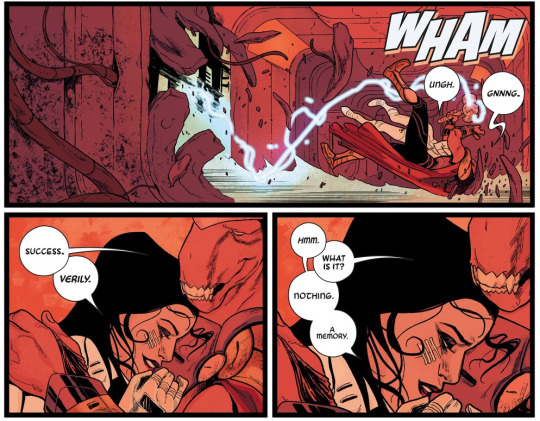
Yeah that memory probably involved something naughty.

You get the idea. She’s attracted to Bill no matter his form.
So in DWJ’s comcic we have Sif dragging Bill to a room and then this happens.
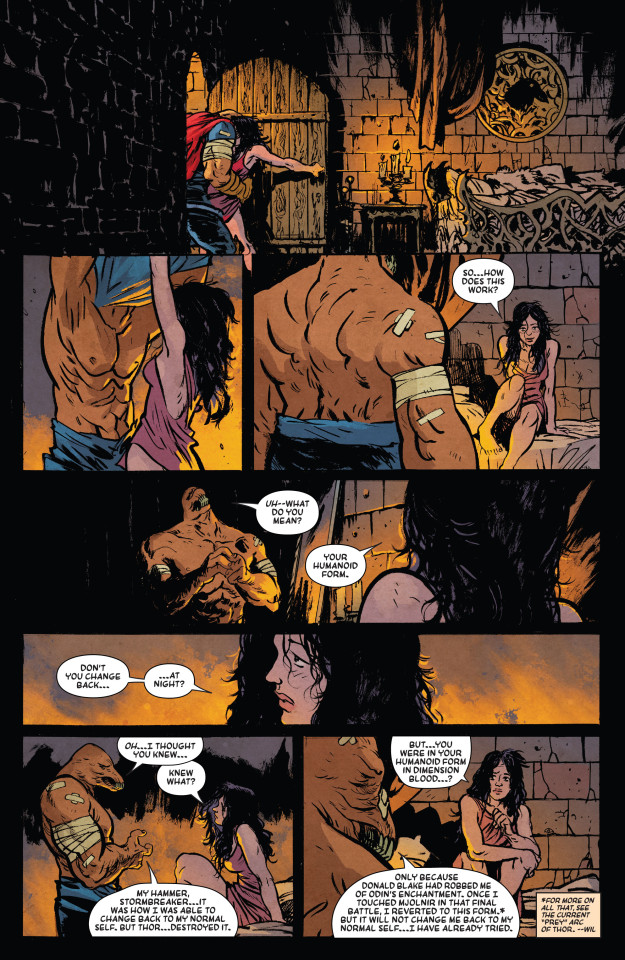

It’s not so much that Sif refused him, that’s fine, but the fact that she intended to have sex with him but only if he was in his humanoid Korbinite form. I don’t see Sif ever doing that to Bill especially knowing how self-conscious and tortured he is about his looks. He makes it clear the first time they meet.
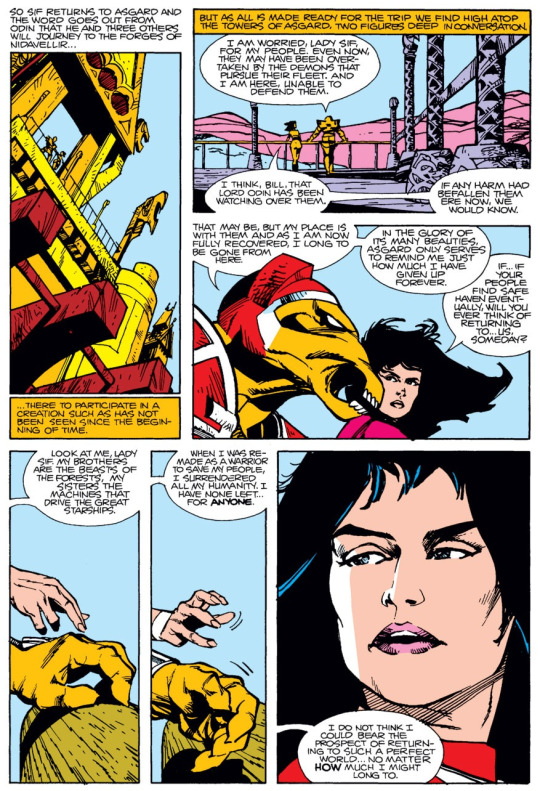
If Sif wasn’t attracted to this Bill and only his humanoid Korbinite form then I don’t think she would ever try to take him to a room with the intention of having sex with him only in his humanoid form. I just don’t see Sif ever doing something like that to him, knowing Bill hates his monstrous form and has trouble finding acceptance in it.
But still this wasn’t the part of the story that bothered me, this was:

I really hated how Thor acted in this, specifically the “I am who I am!” answer after Bill confronted him about getting all the glory. Where did all of Thor’s humility went? It’s not like that’s a major arc for his character why Odin turned him into Donald Blake (and that’s another rant for another day, Don I mean, not the character but what they have done to him and Thor). It sucks but I haven’t really enjoyed a Thor comic since Aaron’s God Butcher arc and I miss Thor when he wasn’t portrayed as a dumb goof or an angry Viking jerk. Give me that regal Kirby and Shakespearian like poetic Thor who occasionally could be an ass but is not devoid of accepting when he was wrong and being empathic towards his friends. The Thor who recited the last rites to a Catholic Priest in the Priest’s religion. TheThor who would be terribly upset if he ever heard Bill say this to him and would want to hear his friend out and do anything to repair their relationship.
Anyway despite that stuff I am still on board for issue 2 and I will refrain from heavily judging this until I’ve read the whole thing.
14 notes
·
View notes
Video
latihan awal utk ganti super hero #thethor #avengersendgame https://www.instagram.com/p/BzmU8DGjVPOMGeF4NPqZrYz6-KLSomWrQwuo9k0/?igshid=1tnfsmdjvsidv
0 notes
Text
Getting reblogged by a...
spiffygriff
thethor(ninmyside)
ptchew
... makes me unimaginably happy for a really satisfying 2 minutes.
It’s like that feeling when I got a rice ball for a guy sleeping on the steps of my workplace. It won’t solve the world’s problems and it won’t solve even all of one person’s problems, but there’s something shared in that moment and it was undeniably something good.
Thanks, friends. You’re the real MVPs.
2 notes
·
View notes
Text
Working with the community to make better games
Philomena Schwab shares her positive experiences with community-based development and everything she has learned about it in the past couple of years.
Why build a community? Well, building a community around your game in development is not only beneficial for financial success but provides developers with constant feedback and can serve as a motivator to push through the tough times of development. For our indie studio Stray Fawn Studio, this was utterly true, and we are very grateful for everything our players helped us to accomplish. In this article, we want to share our story and provide insights on how we built up and maintain a healthy, friendly community and how they helped our games becoming financially successful.
We recently put together a survey, asking indie game developers from all over the world about their experiences with building game communities. You will encounter the results of the survey while reading this article, and here is the first one: According to our survey, 96% of developers believe that community building is relevant for the financial success of indie games. Having a loyal fanbase and financial benefits sound great! But as with most good things it comes at a cost. The initial effort of opening a hub, finding people and establishing an appropriate tone and rules within the community can be quite time-consuming. However, if you are ready to put in some time and effort, the chances are that you are positively surprised by the fruits of your labor.
Philomena wrote her master thesis about community-building for indie game developers. She spent a whole year testing methods to engage, maintain and activate a games’ community.
It‘s all about the game When trying to build up a community or even thinking about what kind of game to develop, the question of the games‘ „hooks“ should be asked early on. Building up a fanbase around a game that has nothing special to offer will be hard. That‘s why you need to think about hooks. Our first game „Niche – a genetics survival game“ defined the following hooks for itself: Scientifically accurate genetics, cute animals, survival genre. When we started Niche‘s development in 2014, no big games about genetics and evolution had been released for a long time, and there weren‘t many survival games available either. Whichever hooks you choose, a game either needs to be unique enough to attract its own audience or be better than existing games it‘s trying to compete with. A game‘s visuals can be a great first hook to get people interested. If the game looks dull or ugly but has excellent gameplay, it will be a tougher sell at first, since people need to play it to be able to tell all their friends how amazing the game is.
There are many other factors about games that can make community-building and discoverability easier; multiplayer for example. Playing with friends can be a great motivator to buy a game and stick with it. Our studio‘s favorite helpful factor is expandability. If you show your game in an early state, you can gather feedback at the beginning of the project. This method can have a positive impact since problems in the core gameplay can be corrected before more is built on top of it. Then, with every new update, players can pick up the game again and discuss all the new changes. This works exceptionally well for system-driven games and can often be seen with games in Early Access. The supreme discipline of expandability is modding support. Letting players create their own content can increase a games‘ lifespan drastically. If a game is heavily story-driven and can‘t be played before it‘s finished, there are other ways to build up a community around it, for example by starting a blog that analyzes games that are similar to yours. The game‘s worlds and characters could be introduced using additional stories and lore. Then, once your game is released, you will have access to people that are interested in exactly the type of game you are creating. Whichever type of game you might create, they all face the same problem: Where to find people that care?
Going to events helped to re-define the target group of Niche. The game was initially intended for a younger audience (kids and teens).
Where to find players? There are many ways to approach this problem. For us, an excellent place to start are events. Events can be great to gather early feedback and to see if the game attracts our chosen target group. With Niche, for example, we weren‘t surprised that many young girls (age 8 – 12) where attracted by the game. What we didn‘t expect however, was that men and women age 25 – 35 were interested in it too. This encouraged us to adjust the concept towards an older target audience, which allowed us to add more complex scientific concepts. When exhibiting at events, newsletter signup lists are a great tool to stay in touch with interested players. Once the game launches, few things are more useful than a long newsletter list of interested people. You don‘t have to start from zero when building a community. There are many already established groups out there that align with your target audience. For Niche, for example, we reached out to the author of a fantasy series about fighting forest cats. Thethor appreciated that her books have inspired our game and gave us a shoutout on her Facebook page. This resulted in lots of teenage girls becoming interested in the game. Of course, we also advertised Niche via social media ourselves, using hashtags and existing groups to reach related communities.
Where to bring them? Once we found a couple of people that cared about our game, the next question was where to bring them. Here is another survey result or you: 45% of all indie developers are currently using Discord as their primary community hub. 16% are using the Steam forums, 8% their own forums and 4% favor Facebook groups. Discord is the most popular option by far. Survey participants stated that it‘s easy to set up, it‘s platform independent (in case a game is planned to be released in different stores or on different platforms), that they appreciate the direct chat functionality and the ability to automate processes using bots. I agree that Discord is currently a great option as a community hub. Other options, such as a Subreddit or Facebook group can work too. The most important requirement for a community hub is that people should be able to interact with each other easily. So in my opinion, sites like Youtube and Twitter are great for gaining visibility, but the interaction of the community should not be limited to leaving a comment on the developer‘s posts.
Thanks to the support of the Swiss Arts Council Pro Helvetia, Stray Fawn Studio was able to present Niche at the Game Developers Conference in San Francisco.
Are you using a forum? Our studio has decided to start running its own forums. The main reason being that after we released our second game, the different channels/hubs were becoming too numerous to maintain and people expected us to be available everywhere. So we decided to declare the new forums as our primary communication outlet and informed our players via pinned posts on all other channels. We still drop into our Discords, Facebook groups, and Subreddits occasionally, but the change to one central news channel relieved some of the pressure to respond everywhere within a short amount of time. Bringing the forums to life was a different beast entirely. For now, it turned out to be a good decision, enabling cross-promotion between our two games and allowing to add many cool features, such as an up- and downvote plugin for feature requests and bug reports. If you‘d like to hear more about why we chose a forum and how we brought it to life, check out my GDC 2019 talk about this topic: strayfawnstudio.com/insights
Stray Fawn Studio is based in Zurich, Switzerland. The team consists of 10 people, half of them graduated from the Zurich University of the Arts’ game design course.
How to manage a community? Once you have found at least a hand-full of interested people and opened up a hub where they can easily communicate, community management begins. The early days of a community are when its fundamental tone and rules are defined. If you do a good job at this point, players will become advocates and pass on the desired behaviors to new members of the group. I like to refer to this phase as „forming the backbone.“ Having a clear vision of your game at this point is important since you want to be able to communicate what players can expect. With Niche, players requested „options to build traps and fences“ after playing the first prototype. We clearly stated that building anything beyond basic structures such as nests would never become a part of the game since the protagonists are animals. After a lengthy discussion, the community members accepted the decision and passed on the knowledge to new members requesting building features ever since. There are quite a few things developers can do to deepen the connection with their community:
Show benefits of being in the community (such as letting them know news first)
Show people that you are human and why you love your game, tell your story
Take the time to explain decisions (especially if people are unhappy about them)
Listen to feedback
Implement suggestions and credit people for them (generates a sense of ownership)
Educate people on how games are created, so they understand the effort
Always be honest and transparent
However ultimately, the developer is not the protagonist of this story. In the end, it‘s all about people making friends. We are only the ones providing the platform for it. If community members become friends, our game is suddenly not the only reason for spending time in our community hubs anymore. Instead of talking about the game exclusively, they will start to discuss all kinds of things. For example in the Niche forums, people post their drawing of animals and ask for feedback. Suddenly, the hub provides an entirely new type of value: Artistic improvement. Now people can easily entertain themselves until the release of our next big game update.
Stray Fawn Studio initially financed Niche and Nimbatus via Kickstarter. Crowdfunding is now a fixed step in their development cycle to test if players are interested in a game concept before working on it for too long.
If all goes well, the community will slowly start to grow on its own. At some point, players might open new hubs by themselves and will ask us to approve them or even drop by occasionally. This is the point in time where moderators become essential. If a moderator is needed, our team often asks people who joined the community during the „backbone phase“ to take on the responsibility. Usually, people feel honored and happily assist. This is a huge time saver since moderators should be able to answer most questions that players have on their own.
What to do next? Now that you have a healthy, growing community in place, what other things besides feedback and ideas can they support you with? One example would be community translation. More and more indie game studios depend on their players when it comes to localizing the game. Niche‘s community has localized the game to eight languages. However, while players understand a game‘s context very well, it might still make sense to let a professional translator double-check the spelling.
Players can also help to create social media content. Our studio often runs „best gif“ competitions for our second game „Nimbatus – The Space Drone Constructor.“ Winners receive a free Steam key, and we get to post their amazing creations on social media.
For their new game Nimbatus – The Space Drone Constructor, Stray Fawn Studio offered everyone who joined the games’ newsletter a free demo before the game was released.
Also, there is the option to ask players for financial support, using sites like Patreon and Kickstarter. Our studio has run Kickstarters for both our games, raising funds that were essential to keep working on the projects. If you are interested in reading more about our games‘ crowdfunding campaigns (Spoiler: One of them got funded thanks to a free demo), you can do so here: strayfawnstudio.com/insights Running a Kickstarter can be a great way to deepen the connection between your players and your team because if a campaign succeeds, the community will celebrate it together with you and feel that they were an essential part of the accomplishment. Also, crowdfunding is a great first step to teaching a community that making a game costs money. Which brings me to my favorite moment with our games‘ fanbase to date. When Niche was ready to leave Early Access in autumn 2017, our team was afraid that the game might not break even financially. So we turned to our community and explained that we would not be able to release further updates for the game anymore if we didn‘t hit the break-even mark of selling 50.000 units during launch month. The community was shocked and asked what they could do to help us. We put together a list of helpful things, such as contacting their favorite YouTubers, streamers, press outlets, as well as sharing posts on social media and telling their friends. This worked out way better than expected. Many prominent YouTubers and streamers picked up the game since their viewers asked them to do so. The game easily surpassed its break-even goal, and our players got to enjoy many more free updates.
Problems we have encountered Looking back now, we had surprisingly few issues with our community. However, I‘d still like to address two of them. The first issue came up when at one point we introduced a new game mechanic. The community was unhappy about the change, and some of the players initiated voting on whether the new mechanic should be removed again. After we set down, discussed and re-iterated the mechanic with them, they started to accept it. However, this kind of strong reaction was something our team wasn‘t prepared for.
Events are not only useful for community-building, but also to meet potential publishers, distributors and other partners that are relevant for the success of an indie studio.
Our second problem was something we could have foreseen from the start: People that like to play survival games and people that like cute animals might not enjoy the same kind of gameplay. Pretty early on it became obvious that we had to cater to two very different interest groups. „The breeders“ wanted life to be peaceful and were mostly interested in breeding animals with all kinds of different patterns. On the other side, we had the „the survivors,“ who wanted to be continuously challenged and didn‘t care about cuteness too much. Luckily, plenty people were filling in the gaps between those two extremes, but it wasn‘t easy to satisfy such a broad interest spectrum in one game, and Niche might have turned out better by focusing on just one of them.
Closing words Even if things got tough sometimes, we would do it all over again. Our community has done more for us than we can ever repay. They have improved our games in many ways through their countless ideas and feedback. Community-based development has become our team‘s favorite way of making games. So hopefully we can keep on making games that both our team and our players love.
Philomena Schwab is the co-founder of Stray Fawn Studio and vice president of the Swiss Game Developers Association (SGDA).
Philomena graduated from the Zurich University of the Arts Game Design Masters program, writing her thesis about community-based development and crowdfunding. She went on to co-found the Zurich-based Indie game studio Stray Fawn, which just released its second game. As vice president of the Swiss Game Developers Association, she tries to help the Swiss games industry grow.
The post Working with the community to make better games appeared first on Making Games.
Working with the community to make better games published first on https://leolarsonblog.tumblr.com/
0 notes
Photo
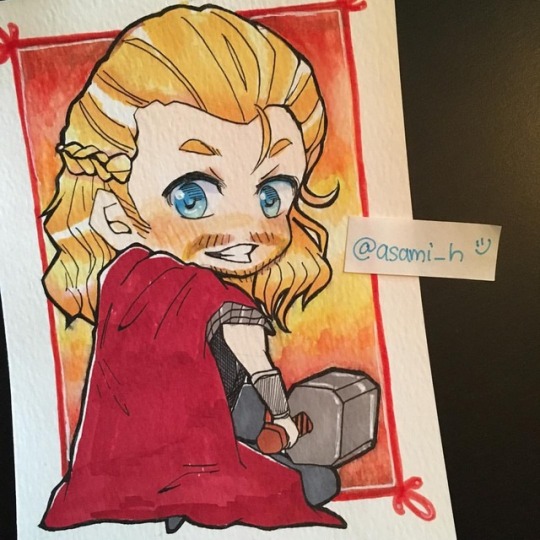
初期 #thor が好きだーっ!!_(:3」z)_ #drawing #fanart #movie #doodle #thethor #marvel #お絵描き #マイティーソー https://www.instagram.com/p/Bo5UOdbldWT/?utm_source=ig_tumblr_share&igshid=1pkt1rus3kd48
3 notes
·
View notes
Link
https://www.wotablog.com/fadein_animation_for_the_thor/
0 notes
Photo

#porchdeck chillin with my homie. #thethor
0 notes
Photo

#thethor #cycling #bburd (at Heiliger Berg)
1 note
·
View note
Photo

Yesterday's food truck adventure @foodtruckbazaar #foodtrucks #orlando #ucf #fullsail #thethor #swedish #hawaiian #bbq #bananawonton #cupcakes
1 note
·
View note
Link
https://www.wotablog.com/wp_blogcard_noplugin/
0 notes